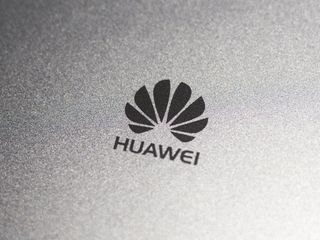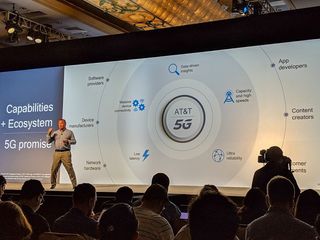How the U.S. missed its chance to own the tech that helped Huawei win 5G

You've read a million different articles about how the ban on Huawei has more to do with the company's 5G network equipment than it does with 5G phones. The U.S. — and by its reckoning, the rest of the "free" world — just can't have Huawei controlling the flow of information across the planet in the near future because it wants to control the flow of information. Really, it's that simple.
Much has been said about the U.S.-led ban on Huawei, but it all comes down to 5G equipment.
While this makes some of us rise up and salute a flag and makes others completely frustrated that phones got caught up in some 5G infrastructure fight, it does make perfect sense. No country wants to get left out when it comes to the trillions of dollars of revenue 5G networks are going to create, never mind the idea that communist China would have too much control over information networks. If you've been paying attention to most of the world for the past 50 or so years, communism, especially the strict Chinese flavor of it, is considered really bad, and pouring trillions of dollars into China is unacceptable for much of the western world.
We're not going to rehash all of this. You can like it or hate it or argue about its merits, but it is what it is — if Huawei were to be allowed to run free with its superior 5G technology, other countries would be left behind, and networks would theoretically be at the mercy of an oppressive communist government.
For it all to make sense, you need to know the background, and now we can.
That's all water under the bridge, but a new article at Wired tells more of the story and gives us a glimpse why Huawei is so far ahead when it comes to 5G, and how a theory crafted in 1948 that was revived by a Turkish professor is the reason. Welcome to the world of information theory.
Claude Shannon worked at Bell Labs in the 1940s, and it was his job to understand everything there was to know about information transport and storage so he could look into ways to make something like the internet a reality. One important bit of work was looking at channel capacity: how much data can be accurately transmitted after electrical noise was accounted for.

40 years later, the solution was to approach the issue by what's known as LDPC (low-density parity-check). This is a method of fixing data errors on the fly. It has evolved into a viable and robust series of calculations that are actually used for data transfer, including 5G networking by companies like Qualcomm. It's robust and it works, as evidenced by Qualcomm's success in 5G.
To move data faster, you need to find better ways to verify the data being sent; traditional methods are too slow for a 5G future.
But a Turkish professor named Erdal Arikan, who had spent years studying the problems of data noise at Cal Tech and MIT and helped found Turkey's first private research institution and engineering school had bigger ideas. Eventually, he theory-crafted what he calls Polar Codes.
Be an expert in 5 minutes
Get the latest news from Android Central, your trusted companion in the world of Android
Polar Coding copies all the noise from a channel onto a clone of the channel, creating one copy with no noise and one copy with all the noise. If the clean channel has errors, the dirty channel can be error checked. If it doesn't, you roll with it at very high transmission rates. In other words, it's a lot faster, and more data can be crunched by the chips that power 5G telecom equipment.
While Arikan didn't think this theory was practical, Huawei did and ran with it. After Nortel's demise in 2009 — you might remember how those patents were snatched up by a group designed to "kill Google" — Huawei convinced the entire Ottawa-based Nortel research lab to stay together under new management. There the final issue with polar codes (they weren't particularly suited to 5G short bursts of data) was overcome, and Huawei started working on filing patents and trying to make polar codes part of the 5G standard.
When the 5G NR (New Radio) standards were set in 2016, Huawei came out a winner. The current 5G NR standards use LDPC for data being sent, and Polar Codes control how the data is moved. Huawei equipment can move data better than its competitors because the standards use ideas and code that Huawei developed.

It's important to understand what makes Huawei's 5G equipment so good. You'll hear a lot about stolen IP and patent theft whenever the word Huawei comes up, and that might be true in some parts of its business. But since the man who actually formulated the basis of what Huawei does with 5G data has spoken, we know it didn't steal any ideas. Huawei actually holds 10 times as many Polar Code patents as its closest rival.
Huawei is going to have plenty of influence over 5G, whether the U.S. likes it or not.
Circle back to the top, and you can see why this doesn't sit well with the U.S. The U.S. has been on the defensive when it comes to 5G tech since Nortel (actually a Canadian company but there used to be a healthy relationship between the U.S. and Canada) shuttered its doors in 2009. All the companies working on 5G equipment are outside the U.S. and while the west is OK with companies like Ericsson having control, having China lead the way is not acceptable. And the U.S. had its chance; Arikan tried to sell the idea of Polar Codes to both Qualcomm and Seagate, but his ideas were declined.
The bigger problem is that whether the U.S. led ban on Huawei's network equipment is warranted or not, it can't change the fact that Huawei is going to power a 5G internet across much of the globe. China alone accounts for much of the world's information traffic. Many other countries in Asia, Africa, the Middle East, and South America will also be using Huawei equipment to power their "global" networks. The west can use products from other companies, but everything has to work together, so plenty of technology needs to be licensed from Huawei.
China is a super-power and, like it or not, is ahead of the curve in many ways when it comes to technology. This is something the world is going to need to reckon with eventually. Let's hope there aren't armies involved in that reckoning.

The S20+ has a great screen, top-end specs, a strong array of cameras, and feature-packed software. And you get 5G on any carrier no matter which company's 5G equipment it uses.

Jerry is an amateur woodworker and struggling shade tree mechanic. There's nothing he can't take apart, but many things he can't reassemble. You'll find him writing and speaking his loud opinion on Android Central and occasionally on Twitter.
